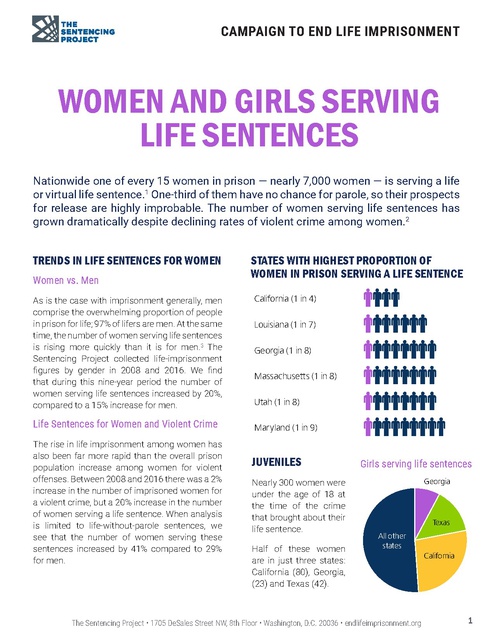The Sentencing Project, Campaign to End Life Imprisonment - Women and Girls Serving Life Sentences, 2019
Download original document:

Document text

Document text
This text is machine-read, and may contain errors. Check the original document to verify accuracy.
CAMPAIGN TO END LIFE IMPRISONMENT WOMEN AND GIRLS SERVING LIFE SENTENCES Nationwide one of every 15 women in prison — nearly 7,000 women — is serving a life or virtual life sentence.1 One-third of them have no chance for parole, so their prospects for release are highly improbable. The number of women serving life sentences has grown dramatically despite declining rates of violent crime among women.2 TRENDS IN LIFE SENTENCES FOR WOMEN Women vs. Men As is the case with imprisonment generally, men comprise the overwhelming proportion of people in prison for life; 97% of lifers are men. At the same time, the number of women serving life sentences is rising more quickly than it is for men.3 The Sentencing Project collected life-imprisonment figures by gender in 2008 and 2016. We find that during this nine-year period the number of women serving life sentences increased by 20%, compared to a 15% increase for men. Life Sentences for Women and Violent Crime The rise in life imprisonment among women has also been far more rapid than the overall prison population increase among women for violent offenses. Between 2008 and 2016 there was a 2% increase in the number of imprisoned women for a violent crime, but a 20% increase in the number of women serving a life sentence. When analysis is limited to life-without-parole sentences, we see that the number of women serving these sentences increased by 41% compared to 29% for men. STATES WITH HIGHEST PROPORTION OF WOMEN IN PRISON SERVING A LIFE SENTENCE California (1 in 4) Louisiana (1 in 7) Georgia (1 in 8) Massachusetts (1 in 8) Utah (1 in 8) Maryland (1 in 9) JUVENILES Nearly 300 women were under the age of 18 at the time of the crime that brought about their life sentence. Half of these women are in just three states: California (80), Georgia, (23) and Texas (42). Girls serving life sentences Georgia Texas All other states The Sentencing Project • 1705 DeSales Street NW, 8th Floor • Washington, D.C. 20036 • endlifeimprisonment.org California 1 CAMPAIGN TO END LIFE IMPRISONMENT WOMEN’S LIFE CIRCUMSTANCES AND LIFE IMPRISONMENT The circumstances that lead women to commit violent crimes are often complicated by a history of sexual and/or physical trauma. Compared to men, women serving life sentences report higher levels of psychiatric disorders, histories of physical and sexual violence, and previous suicide attempts. Over one third of women serving life sentences have attempted suicide.4 In a national survey conducted by The Sentencing Project of people serving life without parole for offenses committed as youth, we found that prior to incarceration, 80% of female respondents had experienced physical abuse, 77% sexual abuse, and 84% witnessed violence at home. Some research suggests that the crimes leading to a life sentence for a woman may be in response to intimate partner victimization.5 One study of 42 survivors of intimate partner abuse convicted of murder in California found that all but two had received life sentences: six were sentenced to life without parole, and the remaining 34 received life sentences with minimums that ranged from 7-15 years, but at the time of the study all these women had already served 25 years.6 Additionally, interview data from 99 women serving life sentences showed that 17% had been convicted of killing their former or current intimate partner, though it was unclear if the murder was related to intimate partner violence. 1. 2. 3. 4. 5. 6. 7. Cyntoia Brown was a victim of sex trafficking who killed a man who solicited her for sex when she was 16 years old. Brown received a life sentence as a result and was required to wait at least 51 years before her first parole hearing.7 Her case earned national attention after a series of Hollywood celebrities elevated her story through social media. Public empathy for the trauma of her life experience and her allegations of selfdefense helped influence Tennessee Governor William Haslam to grant her a commutation of sentence in 2018. In the absence of high-profile cases such as this, commutations are exceedingly rare. CONCLUSION While women represent only 3% of the prisoners sentenced to life imprisonment, they are a growing segment of the lifer population. Reforms advanced to end the use of life sentences will need to pay attention to the nuanced life experiences of women serving life in prison, as these have shaped their behaviors as well as their prison experiences in different ways than men. Nellis, A. (2017). Still Life: America’s Increasing Use of Life and Long-Term Sentences. Washington, DC: The Sentencing Project. A virtual life sentence is defined as a sentence of 50 years or more in prison. Uniform Crime Report. 10-Year Comparison in Crime Trends 2006-2015. Available online: https://ucr.fbi.gov/crime-in-the-u.s/2015/crime-in-theu.s.-2015/tables/table-33 Trend data are available for data regarding sentences of life with parole and life without parole. The Sentencing Project measured “virtual life” sentences beginning in 2016, so virtual life sentences being served by women in 2016 are excluded from trend data analyses. We define virtual life as prison sentences that are 50 years or longer. Leigey, M. & Reed, K. (2010). A Woman’s Life Before Serving Life: Examining the Negative Pre-Incarceration Life Events of Female Life-Sentenced Inmates. Women and Criminal Justice 20: 302-322. Ewing, Charles P. (1987). Battered Women Who Kill: Psychological Self-Defense as Legal Justification. Lexington: Lexington Books. Elizabeth Dermody Leonard, Convicted Survivors: The Imprisonment of Battered Women, Albany, NY: SUNY Press (2002). Tennessee Statute defined a life sentence with parole as 60 years; 85% of the sentence (51 years) must be served before one’s initial parole hearing. The Sentencing Project • 1705 DeSales Street NW, 8th Floor • Washington, D.C. 20036 • endlifeimprisonment.org June 20192

